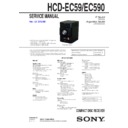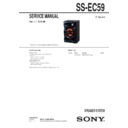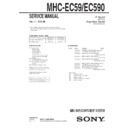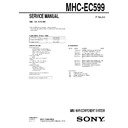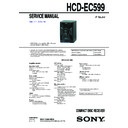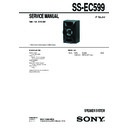Sony HCD-EC59 / HCD-EC590 / MHC-EC59 / MHC-EC590 Service Manual ▷ View online
SERVICE MANUAL
Sony Corporation
Published by Sony Techno Create Corporation
HCD-EC59/EC590
SPECIFICATIONS
COMPACT DISC RECEIVER
9-889-885-03
2012B33-1
©
2012.02
E Model
HCD-EC59
Argentina Model
HCD-EC59/EC590
Ver. 1.2 2012.02
• HCD-EC59 is the amplifi er, USB, CD player and
tuner section in MHC-EC59.
• HCD-EC590 is the amplifi er, USB, CD player
and tuner section in MHC-EC590.
Model Name Using Similar Mechanism
HCD-EX6/EX6T
Base Unit Name
BU-D1BD74UR
Optical Pick-up Block Name
DA11MMVGP
• MPEG Layer-3 audio coding technology and patents licensed from Fraunhofer IIS and Thomson.
• Windows Media is either a registered trademark or trademark of Microsoft Corporation in the
• Windows Media is either a registered trademark or trademark of Microsoft Corporation in the
United States and/or other countries.
• This product is protected by certain intellectual property rights of Microsoft Corporation. Use or
distribution of such technology outside of this product is prohibited without a license from Micro-
soft or an authorized Microsoft subsidiary.
soft or an authorized Microsoft subsidiary.
Main unit
Amplifier section
The following measured at AC 127 V, 60 Hz
(Mexican model)
The following measured at AC 220 V,
50/60 Hz (Argentine model)
The following measured at AC 120 V, 220 V,
240 V, 50/60 Hz (Other models)
(Mexican model)
The following measured at AC 220 V,
50/60 Hz (Argentine model)
The following measured at AC 120 V, 220 V,
240 V, 50/60 Hz (Other models)
HCD-EC59
Power output (rated):
Power output (rated):
25 W + 25 W (at 6 Ω, 1 kHz, 1%
THD)
THD)
RMS output power (reference):
HCD-EC590
Power output (rated):
Power output (rated):
30W + 30W (at 6 Ω, 1kHz, 1%
THD)
60 W + 60 W (per channel at 6 Ω,
1 kHz)
1 kHz)
Inputs
PC IN (stereo mini jack):
Sensitivity 800 mV, impedance
22 kilohms
22 kilohms
Outputs
PHONES (stereo mini jack):
accepts headphones with an
impedance of 8 Ω or more
impedance of 8 Ω or more
SPEAKERS: impedance: 6 Ω
USB section
Supported bit rate:
MP3 (MPEG 1 Audio Layer-3):
32 kbps – 320 kbps, VBR
WMA: 48 kbps – 192 kbps
AAC: 48 kbps – 320 kbps
32 kbps – 320 kbps, VBR
WMA: 48 kbps – 192 kbps
AAC: 48 kbps – 320 kbps
Sampling frequencies:
MP3 (MPEG 1 Audio Layer-3):
32/44.1/48 kHz
WMA: 44.1 kHz
AAC: 44.1 kHz
32/44.1/48 kHz
WMA: 44.1 kHz
AAC: 44.1 kHz
(USB) port:
Maximum current:
500 mA
500 mA
CD player section
System:
Compact disc and digital audio
system
system
Laser Diode Properties
Emission Duration: Continuous
Laser Output*: Less than 44.6μW
* This output is the value
Laser Output*: Less than 44.6μW
* This output is the value
measurement at a distance of
200mm from the objective lens
surface on the Optical Pick-up Block
with 7mm aperture.
200mm from the objective lens
surface on the Optical Pick-up Block
with 7mm aperture.
Frequency response: 20 Hz – 20 kHz
Signal-to-noise ratio: More than 90 dB
Dynamic range: More than 88 dB
Signal-to-noise ratio: More than 90 dB
Dynamic range: More than 88 dB
Tuner section
FM stereo, FM/AM superheterodyne tuner
Antenna:
Antenna:
FM lead antenna
AM loop antenna
AM loop antenna
FM tuner section:
Tuning range:
Tuning range:
87.5 MHz – 108.0 MHz (50 kHz step)
Intermediate frequency: 225 kHz
AM tuner section:
Tuning range
Latin American models:
Tuning range
Latin American models:
530 kHz – 1,710 kHz (10 kHz step)
531 kHz – 1,710 kHz (9 kHz step)
531 kHz – 1,710 kHz (9 kHz step)
Other models:
531 kHz – 1,602 kHz (9 kHz step)
530 kHz – 1,610 kHz (10 kHz step)
530 kHz – 1,610 kHz (10 kHz step)
Intermediate frequency: 53 kHz
General
Power requirements
Mexican model:
AC 127 V, 60 Hz
Argentine model:
AC 220 V, 50/60 Hz
Other models:
AC 120 V, 220 V or 230 V – 240 V,
50/60 Hz, adjustable with voltage
selector
AC 127 V, 60 Hz
Argentine model:
AC 220 V, 50/60 Hz
Other models:
AC 120 V, 220 V or 230 V – 240 V,
50/60 Hz, adjustable with voltage
selector
Power consumption: 85 W
(0.5 Wat the Power Saving Mode)
Dimensions (W/H/D) (excl. speakers)
Approx. 200 mm × 306 mm ×
305 mm
305 mm
Mass (excl. speakers): Approx. 3.8 kg
Design and specifications are subject to
change without notice.
change without notice.
Standby power consumption: 0.5 W
Halogenated flame retardants are not used
in the certain printed wiring boards.
Halogenated flame retardants are not used
in the certain printed wiring boards.
Photo: HCD-EC59
HCD-EC59/EC590
2
1.
SERVICING NOTES
............................................. 3
2. DISASSEMBLY
2-1. Disassembly
Flow
........................................................... 6
2-2. Side Panel (L)/(R) ........................................................... 7
2-3. Top
2-3. Top
Panel
Assy
................................................................ 7
2-4. Front Panel Block ........................................................... 8
2-5. Knob
2-5. Knob
(VOL)
.................................................................... 8
2-6. MAIN
Board
................................................................... 9
2-7. Base Unit (BU-D1BD74UR) .......................................... 10
2-8. Optical Pick-up Block (DA11MMVGP) ........................ 10
2-8. Optical Pick-up Block (DA11MMVGP) ........................ 10
3.
TEST MODE
............................................................ 11
4.
ELECTRICAL CHECKS
...................................... 13
5. DIAGRAMS
5-1. Printed Wiring Board - CD Section - .............................. 18
5-2. Schematic Diagram - CD Section - ................................. 19
5-3. Printed Wiring Board - USB Section - ............................ 20
5-4. Schematic Diagram - USB Section - .............................. 21
5-5. Printed Wiring Boards - MAIN Section - ....................... 22
5-6. Schematic Diagram - MAIN Section - ........................... 23
5-7. Printed
5-2. Schematic Diagram - CD Section - ................................. 19
5-3. Printed Wiring Board - USB Section - ............................ 20
5-4. Schematic Diagram - USB Section - .............................. 21
5-5. Printed Wiring Boards - MAIN Section - ....................... 22
5-6. Schematic Diagram - MAIN Section - ........................... 23
5-7. Printed
Wiring
Boards
- 2CH AMP/USB-JACK/JACK Boards - ....................... 24
5-8. Schematic
Diagram
- 2CH AMP/USB-JACK/JACK Boards - ....................... 25
5-9. Printed Wiring Board - PANEL Board - ......................... 26
5-10. Schematic Diagram - PANEL Board - ............................ 27
5-11. Printed Wiring Board
5-10. Schematic Diagram - PANEL Board - ............................ 27
5-11. Printed Wiring Board
- PT-SWITCH Board (SUFFIX-11) - ............................. 28
5-12. Printed Wiring Board
- PT-SWITCH Board (SUFFIX-12) - ............................ 28
5-13. Schematic Diagram - PT-SWITCH Board - ................... 29
6.
EXPLODED VIEWS
6-1. Overall
Section
............................................................... 32
6-2. Front Panel Section ......................................................... 33
6-3. Chassis
6-3. Chassis
Section
............................................................... 34
6-4. Top Panel Section ........................................................... 35
7.
ELECTRICAL PARTS LIST
.............................. 36
Accessories are given in the last of the electrical parts list.
TABLE OF CONTENTS
NOTES ON CHIP COMPONENT REPLACEMENT
• Never reuse a disconnected chip component.
• Notice that the minus side of a tantalum capacitor may be dam-
• Never reuse a disconnected chip component.
• Notice that the minus side of a tantalum capacitor may be dam-
aged by heat.
FLEXIBLE CIRCUIT BOARD REPAIRING
• Keep the temperature of soldering iron around 270 °C during
• Keep the temperature of soldering iron around 270 °C during
repairing.
• Do not touch the soldering iron on the same conductor of the
circuit board (within 3 times).
• Be careful not to apply force on the conductor when soldering
or unsoldering.
CAUTION
Use of controls or adjustments or performance of procedures
other than those specifi ed herein may result in hazardous radia-
tion exposure.
Use of controls or adjustments or performance of procedures
other than those specifi ed herein may result in hazardous radia-
tion exposure.
This appliance is classifi ed as
a CLASS 1 LASER product.
This marking is located on the
rear exterior.
a CLASS 1 LASER product.
This marking is located on the
rear exterior.
SAFETY-RELATED COMPONENT WARNING!
COMPONENTS IDENTIFIED BY MARK 0 OR DOTTED LINE
WITH MARK 0 ON THE SCHEMATIC DIAGRAMS AND IN
THE PARTS LIST ARE CRITICAL TO SAFE OPERATION.
REPLACE THESE COMPONENTS WITH SONY PARTS
WITH MARK 0 ON THE SCHEMATIC DIAGRAMS AND IN
THE PARTS LIST ARE CRITICAL TO SAFE OPERATION.
REPLACE THESE COMPONENTS WITH SONY PARTS
WHOSE PART NUMBERS APPEAR AS SHOWN IN THIS
MANUAL OR IN SUPPLEMENTS PUBLISHED BY SONY.
MANUAL OR IN SUPPLEMENTS PUBLISHED BY SONY.
Ver. 1.1
Note: Refer to the “2CH AMP AND PT-SWITCH BOARDS
DISCRIMINATION” (page 14) for how to distinguish
SUFFIX-11 and SUFFIX-12.
SUFFIX-11 and SUFFIX-12.
HCD-EC59/EC590
3
SECTION 1
SERVICING NOTES
UNLEADED SOLDER
Boards requiring use of unleaded solder are printed with the lead-
free mark (LF) indicating the solder contains no lead.
(Caution: Some printed circuit boards may not come printed with
Boards requiring use of unleaded solder are printed with the lead-
free mark (LF) indicating the solder contains no lead.
(Caution: Some printed circuit boards may not come printed with
the lead free mark due to their particular size)
: LEAD FREE MARK
Unleaded solder has the following characteristics.
• Unleaded solder melts at a temperature about 40 °C higher
• Unleaded solder melts at a temperature about 40 °C higher
than ordinary solder.
Ordinary soldering irons can be used but the iron tip has to be
applied to the solder joint for a slightly longer time.
applied to the solder joint for a slightly longer time.
Soldering irons using a temperature regulator should be set to
about 350 °C.
Caution: The printed pattern (copper foil) may peel away if
about 350 °C.
Caution: The printed pattern (copper foil) may peel away if
the heated tip is applied for too long, so be careful!
• Strong
viscosity
Unleaded solder is more viscous (sticky, less prone to fl ow)
than ordinary solder so use caution not to let solder bridges
occur such as on IC pins, etc.
than ordinary solder so use caution not to let solder bridges
occur such as on IC pins, etc.
• Usable with ordinary solder
It is best to use only unleaded solder but unleaded solder may
also be added to ordinary solder.
also be added to ordinary solder.
NOTES ON HANDLING THE OPTICAL PICK-UP
BLOCK OR BASE UNIT
BLOCK OR BASE UNIT
The laser diode in the optical pick-up block may suffer electro-
static break-down because of the potential difference generated by
the charged electrostatic load, etc. on clothing and the human body.
During repair, pay attention to electrostatic break-down and also
use the procedure in the printed matter which is included in the
repair parts.
The fl exible board is easily damaged and should be handled with
care.
static break-down because of the potential difference generated by
the charged electrostatic load, etc. on clothing and the human body.
During repair, pay attention to electrostatic break-down and also
use the procedure in the printed matter which is included in the
repair parts.
The fl exible board is easily damaged and should be handled with
care.
NOTES ON LASER DIODE EMISSION CHECK
The laser beam on this model is concentrated so as to be focused
on the disc refl ective surface by the objective lens in the optical
pickup block. Therefore, when checking the laser diode emission,
observe from more than 30 cm away from the objective lens.
The laser beam on this model is concentrated so as to be focused
on the disc refl ective surface by the objective lens in the optical
pickup block. Therefore, when checking the laser diode emission,
observe from more than 30 cm away from the objective lens.
LASER DIODE AND FOCUS SEARCH OPERATION
CHECK
During normal operation of the equipment, emission of the laser
diode is prohibited unless the upper lid is closed while turning on
the SW305 (push switch type).
The following checking method for the laser diode is operable.
CHECK
During normal operation of the equipment, emission of the laser
diode is prohibited unless the upper lid is closed while turning on
the SW305 (push switch type).
The following checking method for the laser diode is operable.
• Method
Emission of the laser diode is visually checked.
1. Open the upper lid.
2. Push the SW305 as shown in Fig. 1.
Emission of the laser diode is visually checked.
1. Open the upper lid.
2. Push the SW305 as shown in Fig. 1.
Note: Do not push the detection lever strongly, or it may be bent or
damaged.
3. Check the object lens for confi rming normal emission of the
laser diode. If not emitting, there is a trouble in the automatic
power control circuit or the optical pick-up.
power control circuit or the optical pick-up.
In this operation, the object lens will move up and down 2
times along with inward motion for the focus search.
SW305
Fig. 1. Method to push the SW305
CAPACITOR ELECTRICAL DISCHARGE PROCESSING
When checking the board, the electrical discharge is necessary for
the electric shock prevention. Connect the resistors referring to the
fi gure below.
When checking the board, the electrical discharge is necessary for
the electric shock prevention. Connect the resistors referring to the
fi gure below.
• MAIN board (C622, C626)
Both ends of respective capacitors.
Both ends of respective capacitors.
800
:/2 W
800
:/2 W
– MAIN Board (Conductor Side) –
C622
C626
HCD-EC59/EC590
4
MAIN BOARD SERVICE POSITION
• SIDE PANEL (L) was removed.
MODEL IDENTIFICATION
Distinguish the destination by referring to the model number label or the model number plate or the sculpture of back panel .
Distinguish the destination by referring to the model number label or the model number plate or the sculpture of back panel .
MAIN board
– Rear side view –
Argentina, Mexican and African models
Argentina model
4-184-199-0s AR
4-290-683-0s AR
Mexican model
4-184-200-0s MX
African model
Argentina model
4-184-201-0s E4
Back Panel
MODEL NUMBER LABEL (EC59)
MODEL NUMBER PLATE (EC590)
120V AC area in E model, Chilean and Peruvian models
Sculpture
Back Panel
Ver. 1.1

